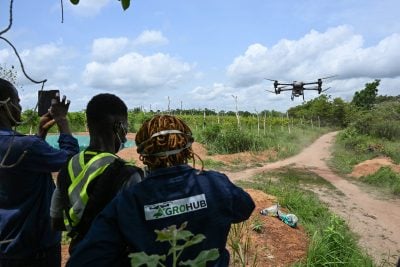Tearing through the Japanese countryside at speeds of up to 320km/h, the Shinkansen bullet train carried two of Asia’s most powerful statesman on a diplomatic mission from Tokyo to the port city of Kobe.
Face-to-face in the padded seats, Indian prime minister Narendra Modi and his Japanese counterpart Shinzo Abe poured on the diplomatic charm while promoting an iconic example of Japanese engineering soon to connect cities in India. For the business-minded reformers – both of whom have staked their credibility on delivering dramatic economic improvements at home – this bullet-train diplomacy represents one strand in a global vision with Africa at its heart.
Conceived on the same November trip, the Asia-Africa Growth Corridor (AAGC) offers an ambitious reboot of the partners’ long-standing economic and development ties with the continent. From development projects to infrastructure investment and people-to-people ties, the scheme promises to open up a new era of cooperation and offer renewed impetus to efforts long overshadowed by the hyperactive African role of China.
Critics believe that the scheme is a continuation of Asia’s bitter regional rivalries – a crude bid to contain the African ambitions of a resurgent China by replicating its One Belt, One Road global trade initiative. But at the African Development Bank meeting in May – held in India for the first time – African and Asian policymakers delighted in talk of infrastructure windfalls, fresh development cash and the establishment of new maritime routes. And for private sector representatives, the embryonic scheme offers tantalising commercial prospects.
“There are a number of dimensions to this. India and Japan have common cause in geopolitical terms, conceptualised in the Asia-Africa Growth Corridor as part of broader Indo-Pacific cooperation,” says Christopher Marks, head of emerging markets in the corporate banking division for Europe, the Middle East and Africa at Mitsubishi UFJ Financial Group.
“India can be thought of a stepping stone, with all its comfort in operating in complicated tropical environments. Japanese joint ventures are very comfortable in India, and therefore the grafting of Japanese technology and supply chain efficiency finds a natural home in India.”
Leaving Asia
For Abe, whose premiership has been premised on a bold reversal of decades of Japanese stagnation, encouraging the country’s giant corporate conglomerates to venture beyond the domestic market remains a priority.
Hostage to an ageing population, high business costs and stiff regulation, ultra-conservative Japanese corporates squatted on some $828bn in cash reserves in the aftermath of the 2008 financial crisis. African policymakers – particularly those in resource-bearing countries – became far more familiar with the philanthropic support of Japanese development experts than the suited salarymen of Japan Inc.
“The feeling was that the Japanese have missed the African boat over the last 15 years,” says Amit Saxena, managing director of Indian investment banking firm MindCap Business Advisory. “Internationally Japan has close to around 70,000 companies active out of Japan. Asia roughly has 50,000 of those, whereas Africa has only around 700.”
Having reduced corporate taxes and offered $30bn in public and private support to Africa by 2018 at the TICAD forum in Nairobi last year, Abe’s message to Japan’s corporate cash hoarders is clear – go forth and spend.
“There’s an imperative on the broader corporate side, inherent in prime minister Abe’s push, to move Japanese business overseas… Japan is too technologically advanced, its institutions too large, to stay at home. Africa is an interesting prospect for a high value producing country like Japan and Japan’s place in the global supply and consumer chains. If we look at the composition of Japan’s overseas development assistance you see an evolution from pure human development support. There’s now a parallel and growing emphasis on private sector development,” says Marks.
For India, the growth corridor represents the ramping up of an already robust commercial engagement with the continent. Supported by regular high-level summits and the energetic diplomacy of Modi – who conducted a whistle-stop tour of Mozambique, Tanzania, South Africa and Kenya in July 2016, the AAGC offers India the chance to consolidate its place as the continent’s second largest trading partner.
India traded some $59bn of goods with Africa in 2015, according to global consulting firm McKinsey, marginally ahead of France, the US and Germany, but still a footnote compared to China’s $188bn. Despite a historic business presence on the continent – especially on the East African coast – corporate India has yet to realise its full potential in Africa, with the country outside the top five for both FDI stock and FDI growth as of 2014.
“Indian companies have been in some African regions for at least 150 years and in some areas have grown rapidly over the past 30 to 40 years, so there’s a significant amount of private entrepreneurial spirit,” says Saxena. “I think this will be matched by the Japanese companies because there’s an underlying push from government to companies saying that we feel we are late to the party.”
An unlikely partnership
For some, the idea of a joint African approach by Japan and India, the former mature and industrialised, the latter an emerging superpower grappling with its own development, appears eccentric. Yet as Asia’s two most powerful democracies and staunch military allies of the US, the partners have long enjoyed close relations rooted in annual bilateral talks and robust economic and security cooperation.
In order to harmonise their visions for the growth corridor, the countries have commissioned a vision document laying out four central targets of the scheme – infrastructure improvements, stronger people-to-people links, skill upgrading, and additional development assistance.
“The layman’s way of thinking is that this is an infrastructure corridor,” says Anita Prakash, director general of the policy department at the Economic Research Institute for ASEAN and East Asia and a consultant member of the vision document research team. “That is only one part of it. The idea is that you are creating or investing your energy in new production channels and reinvigorating old ones. The old relations are being renewed through a more innovative approach and new connectivity including transport, trade facilitation and regulatory activities.”
The vision document talks optimistically of combining Japanese finance, supply chain efficiency and infrastructure delivery with India’s developmental experience and familiarity with cheap, adaptable technologies. The largely undefined nature of the scheme is exciting a diverse range of interests.
Japan’s world-leading components manufacturers are eyeing new customers in African assembly factories, while Indian shipping companies anticipate new ports that could offer Africa outlets to Myanmar and other Asian countries. Manufacturers are particularly energised by the promise of the scheme.
“There’s been an evolution in the composition of Japanese FDI to countries that are more diversified and advanced on the manufacturing path, which is the big development imperative,” says Marks. Morocco, Kenya, Côte d’Ivoire are all destinations not only because they are growing fast but industry is more diverse. The evolution of the underlying direction of sustainable growth countries is towards a composition of domestic production and production for export which suits Japan’s offering far more than a decade ago.”
But as well as exciting corporate minds in Mumbai and Tokyo, AAGC thinkers are keen to stress that the corridor will offer a central role to Africa by aligning Japanese and Indian goals with the development priorities of partner regions and countries, especially in the areas of agriculture, disaster management, health and pharmaceuticals. Organisers are also keen to assuage concerns that Indian and Japanese corporates will use the trade corridor to dump cheap exports onto fragile African manufacturers.
“The plans would be to produce semi-finished products by Japanese companies in India then export them to Africa and have African skilled manpower turn them from semi-finished to finished products… In order to have a distinct identity it is very important that we don’t flood partnering countries and their markets with goods produced in only one or two countries,” says Sachin Chaturvedi, director general of Indian thinktank Research and Information Systems for Developing Countries, and a vision document research team member.
That incremental approach to development, focusing on African jobs and aspirations, has led many pundits to contrast the AAGC with the traditionally prescriptive role of Chinese assistance. The fact that the corridor is taking shape just months after the official summit for China’s One Belt, One Road – an event which India boycotted over concerns about its influence on the disputed region of Kashmir – has raised suspicions that India and Japan are more interested in using the AAGC as a counterweight to the influence of their regional rival.
Yun Sun, non-resident fellow at the Brookings Institution’s Africa Growth Initiative, says that AAGC’s emphasis on Indian Ocean navigational freedom is likely to upset China given Beijing’s reliance on African support for maritime disputes in the South China Sea. China’s general views of Japanese activities in Africa, which include a military base in Djibouti, are “mostly negative”, she argues.
Yet AAGC organisers are keen to downplay the rivalry. “It is simply not correct because the contours, objectives and criteria are so different. The gaps in infrastructure are so huge that there is possibly scope of them being complementary and not competitive,” says Chaturvedi.
Impact is all-important
Yet even if geopolitical rivalry is not at the heart of the scheme, pundits believe that the AAGC will require a disciplined, results-based approach if it is to stand out from the raft of initiatives promising to kickstart Africa’s development.
“For it to have a real impact they should choose one or two regions and make a solid impact over the next year and a half to two years, not just focusing on large projects but SMEs, business services and real integration with African businesses,” says Saxena.
“Instead of making large summits happen and trade ministers and prime ministers shaking hands – which is good – what is really required is to have small Indian, African and Japanese teams identifying companies and projects, going on the ground, and being accountable for action. If you don’t have accountability, everything tends to dissipate in the noise of governments and bureaucracy.”
David Thomas
Want to continue reading? Subscribe today.
You've read all your free articles for this month! Subscribe now to enjoy full access to our content.
Digital Monthly
£8.00 / month
Receive full unlimited access to our articles, opinions, podcasts and more.
Digital Yearly
£70.00 / year
Our best value offer - save £26 and gain access to all of our digital content for an entire year!

 Sign in with Google
Sign in with Google 




